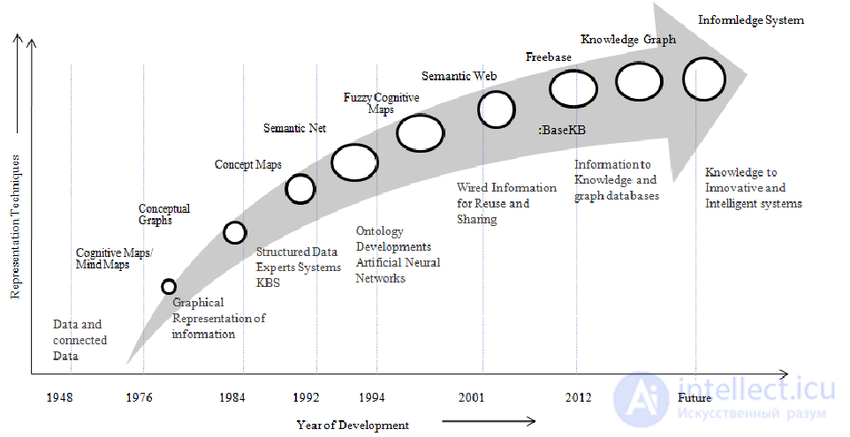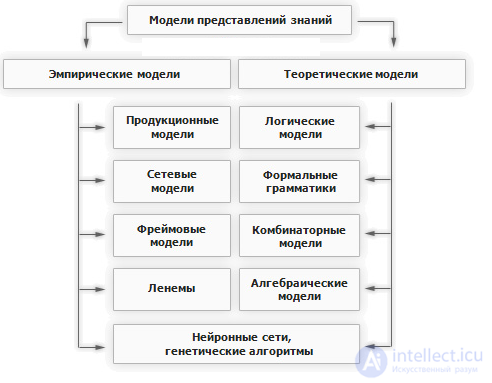Lecture
Representation of knowledge is a question that arises in cognitive science (the science of thinking), in computer science and in the research of artificial intelligence. In cognitive science, it is related to the way people store and process information. In computer science - with the selection of the presentation of specific and generalized knowledge, information and facts for the accumulation and processing of information in a computer. The main task in artificial intelligence (AI) is to learn to store knowledge in such a way that programs can intelligently process them and achieve the similarity of human intelligence.
The term “knowledge representation” most often refers to ways of representing knowledge, oriented to automatic processing by modern computers, and, in particular, representations consisting of explicit objects ('class of all elephants', 'Clyde is an individual') and of judgments or statements about them ('Clyde - elephant', 'all elephants are gray'). Representation of knowledge in such an explicit form allows computers to draw deductive conclusions from previously stored knowledge ('Clyde - gray').
AI researchers use cognitive knowledge representation theories. Methods such as frames, inference rules and semantic networks came to AI from human theories of information processing. Since knowledge is used to achieve rational behavior, the fundamental purpose of the discipline of knowledge representation is the search for such ways of representation that make the process of logical inference possible, that is, knowledge creation from knowledge.
Some questions that arise in the representation of knowledge from the point of view of AI:
There has been very little scrupulous, downward discussion of knowledge representation issues, and research in this area has in fact not advanced in recent years. There are well-known problems, such as “spreading activation” (the task of navigating a network of nodes), categorization (this is related to selective inheritance; for example, an all-terrain vehicle can be considered a specialization (special case) of a car, but it inherits only certain characteristics) and classification. For example, a tomato can be considered both a fruit and a vegetable.
Solving complex problems can often be simplified by choosing the right method of knowledge representation. The defined method can make any area of knowledge easily representable. For example, the MYCIN diagnostic expert system used a rule-based knowledge representation scheme. Wrong choice of presentation method makes processing difficult. As an analogy, you can take the calculations in the Indo-Arabic or Roman record. Column division is simpler in the first case and harder in the second. Similarly, there is no such way of representation that could be used in all tasks, or to make all tasks equally simple.
For the structuring of information, as well as the organization of knowledge bases and expert systems, several ways of representing knowledge were proposed. One of them is the presentation of data and information within the framework of a logical model of knowledge bases.

In the 1960s and the early 1980s, numerous methods of knowledge representation, such as heuristic question-answer systems, neural networks, proof of theorems, and expert systems, were proposed with varying success. The main areas of application at that time were medical diagnostics (MYCIN) and games (for example, chess).
In the 1980s, formal computer languages of knowledge representation appeared. The main projects of that time tried to code (add to their knowledge bases) huge arrays of human knowledge. For example, in the project “Cyc” a large encyclopedia was processed, and not the information stored in it was encoded, but the knowledge that the reader would need to understand this encyclopedia: naive physics, concepts of time, causality and motivation, typical objects and their classes. The Cyc project is being developed by Cycorp, Inc .; most (but not all) of their base is freely available.
This work has led to a more accurate assessment of the complexity of the task of knowledge representation. At the same time, much more extensive databases of language information were created in mathematical linguistics, and they, together with the tremendous increase in the speed and memory capacities of computers, made the deeper knowledge representation more realistic.
Several knowledge-oriented programming languages have also been developed. The prologue (developed in 1972, [1] but gained popularity much later) describes statements and the main logic, and can produce conclusions from known premises. Even more focused on the presentation of knowledge language KL-ONE (1980s).
In the field of electronic documents, languages have been developed that explicitly express the structure of stored documents, such as SGML (and subsequently XML). They have facilitated the task of searching and extracting information, which in recent times has been increasingly associated with the task of representing knowledge. There is great interest in semantic web technology, in which XML-based knowledge representations, such as RDF, Theme Map, and others, are used to increase the availability of information stored on the network to computer systems.
Today, hyperlinks are widely used, but the close concept of semantic link has not yet become widely used. Since the times of Babylon, mathematical tables have been used. Later, these tables were used to represent the results of logical operations, for example, truth tables were used to study and simulate Boolean logic. Table processors are also an example of a tabular representation of knowledge. Another method of knowledge representation is trees, with the help of which one can show connections between fundamental concepts and their derivatives.
A relatively new approach to knowledge management is visual presentation methods, for example, developed by TheBrain Technologies Corp. "Plex". They give the user a way to visualize how a thought or an idea is related to other ideas, allowing you to move from one thought to another in order to find the required information. This approach is developed by several companies. Other visual search tools are created by Convera, Entopia, Inc., EPeople Inc., and Inxight Software Inc.
One of the problems in the representation of knowledge is how to store and process knowledge in information systems in a formal way so that machines can use it to achieve their goals. Examples of applications are expert systems, machine translation, computerized maintenance, and information retrieval and retrieval systems (including user database interfaces).
You can use semantic networks to represent knowledge. Each node in such a network represents a concept, and arcs are used to define the relationship between the concepts.
One of the most expressive and detailed paradigms of knowledge representation based on semantic networks is MultiNet (an acronym for “multi-layer extended semantic networks”, English Multilayered Extended Semantic Networks ).
Since the 1960s, the concept of a knowledge frame or simply a frame has been used . Each frame has its own name and a set of attributes , or slots that contain values; for example, a frame house might contain slots color , number of floors, and so on.
The use of frames in expert systems is an example of object-oriented programming with property inheritance, which is described by the “is-a” relationship (“is”). However, there were quite a few contradictions in the use of the “is-a” connection: Ronald Brahman wrote a paper entitled “What is and is not IS-A”, in which 29 different is-a link semantics were found in projects whose knowledge representation schemes included is-a connection. Other links include, for example, “has-part” (“has its part”).
Frame structures are well suited for representing knowledge presented in the form of diagrams and stereotypical cognitive patterns. Elements of such patterns have different weights, with large weights assigned to those elements that correspond to the current cognitive scheme (schema). The pattern is activated under certain conditions: if a person sees a big bird, provided that his “marine scheme” is active, and the “terrestrial scheme” is not, he classifies it more like a sea eagle, and not a land eagle.
Frame representations are object-centered in the same sense as the semantic network: all the facts and properties associated with one concept are placed in one place, so no need to spend resources on searching the database.
A script is a frame type that describes a sequence of events in time; A typical example is a description of a trip to a restaurant. Events here include waiting for a place, reading a menu, placing an order, and so on.
Different solutions, depending on their semantic expressiveness, can be organized in the so-called semantic spectrum (English Semantic spectrum ).
Some people believe that it will be best to represent knowledge in the same way as they are represented in the human mind, which is the only working mind known today, or to represent knowledge in the form of a natural language. Dr. Ballard, for example, developed a “semantic system based on a theory,” which does not depend on the language, which derives the goal and argues with the same concepts and theories as humans. The formula underlying this semantics is: Knowledge = Theory + Information. Most common database applications and systems are language based. Unfortunately, we do not know how knowledge is represented in the human mind, or how to manipulate natural languages in the same way as humans do. One of the clues is that primates know how to use the point-and-click user interfaces ( Point-and-click ); thus, the sign interface seems to be part of our cognitive apparatus, a modality that is not tied to oral language, and that exists in other animals besides humans.
Therefore, for the presentation of knowledge, various artificial languages and notations were proposed. They are usually based on logic and mathematics, and have easy-to-read grammar to facilitate machine processing. Usually they fall into a wide area of ontologies.
Notation
The latest fashion in knowledge representation languages is the use of XML as a low-level syntax. This leads to the fact that machines can easily produce syntax analysis and output of these knowledge representation languages, due to human readability.
First order logic and Prolog language is widely used as a mathematical basis for these systems to avoid excessive complexity. However, even simple systems based on this simple logic can be used to present data that is significantly better than the processing capabilities of current computer systems: reasons are disclosed in the theory of computability.
Examples of notations:
Languages
Languages are divided into artificial and natural.
Natural languages were formed and formed by national or professional communities of people. Knowledge is transferred from one person to another, after their translation into a language that a person understands as a source of knowledge and a person who receives knowledge.
Artificial languages were created and are being created to connect humans with machines.
Examples of artificial languages that are mainly used to represent knowledge:
Methods and formalisms of knowledge representation - the name of section I.2.4 in the ACM Computer Classification ( ACM Computing Classification System ).
This section is located under:
It includes the following topics:

Comments
To leave a comment
Presentation and use of knowledge
Terms: Presentation and use of knowledge